

Wadjet. Two images of Wadjet appear on this carved wall in the Hatshepsut Temple at Luxor Wadjet (/ˈwɑːdˌdʒɛt/ or /ˈwædˌdʒɛt/; Egyptian wꜣḏyt, "green one"),[1] known to the Greek world as Uto /ˈjuːtoʊ/ or Buto /ˈbjuːtoʊ/ among other names, was originally the ancient local goddess of the city of Dep (Buto),[2] which became part of the city that the Egyptians named Per-Wadjet, House of Wadjet, and the Greeks called Buto (Desouk now),[3] a city that was an important site in the Predynastic era of Ancient Egypt and the cultural developments of the Paleolithic.
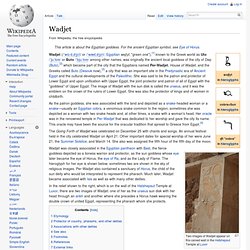
She was said to be the patron and protector of Lower Egypt and upon unification with Upper Egypt, the joint protector and patron of all of Egypt with the "goddess" of Upper Egypt. The image of Wadjet with the sun disk is called the uraeus, and it was the emblem on the crown of the rulers of Lower Egypt. She was also the protector of kings and of women in childbirth. Etymology[edit] Set (mythology) Set /sɛt/ or Seth (/sɛθ/; also spelled Setesh, Sutekh,[1] Setekh, or Suty) is a god of the desert, storms, disorder, violence and foreigners in ancient Egyptian religion.[2] In Ancient Greek, the god's name is given as Sēth (Σήθ).
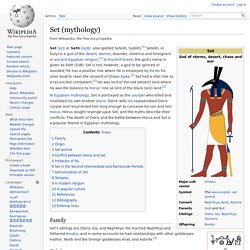
Set is not, however, a god to be ignored or avoided; he has a positive role where he is employed by Ra on his solar boat to repel the serpent of Chaos Apep.[2] Set had a vital role as a reconciled combatant.[2] He was lord of the red (desert) land where he was the balance to Horus' role as lord of the black (soil) land.[2] In Egyptian mythology, Set is portrayed as the usurper who killed and mutilated his own brother Osiris.
Osiris' wife Isis reassembled Osiris' corpse and resurrected him long enough to conceive his son and heir Horus. Horus sought revenge upon Set, and the myths describe their conflicts. The death of Osiris and the battle between Horus and Set is a popular theme in Egyptian mythology. Family Set's siblings are Osiris, Isis, and Nephthys. Origin. Seth animal. Hieroglyphic representation[edit]
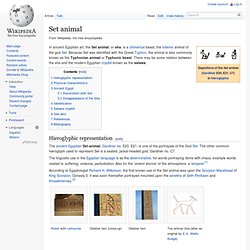
Seth (Egyptian god. Anuket. In Egyptian mythology, Anuket (also spelt Anqet, and in Greek, Anukis) was originally the personification and goddess of the Nile river, in areas such as Elephantine, at the start of the Nile's journey through Egypt, and in nearby regions of Nubia.

Anuket was part of a triad with the god Khnum, and the goddess Satis. She is the sister of the goddess Satis, or she may have been a junior consort to Khnum instead. [1] Anuket was depicted as a woman with a headdress of feathers [1] (thought by most Egyptologists to be a detail deriving from Nubia). [citation needed] Her sacred animal was the gazelle. A temple dedicated to Anuket was erected on the Island of Seheil. Inscriptions show that a shrine or altar was dedicated to her at this site by the 13th dynasty Pharaoh Sobekhotep III. Apep. Development[edit]
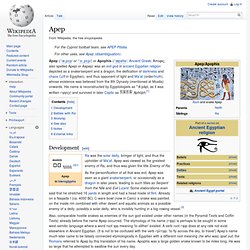
Apepi (pharaoh) Dagger with the names Neb-Khepesh-Re Apepi.
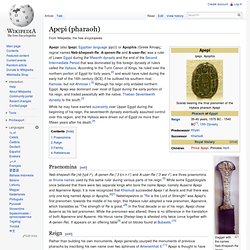
While he may have exerted suzerainty over Upper Egypt during the beginning of his reign, the seventeenth dynasty eventually assumed control over this region, and the Hyksos were driven out of Egypt no more than fifteen years after his death.[4] Rather than building his own monuments, Apepi generally usurped the monuments of previous pharaohs by inscribing his own name over two sphinxes of Amenemhat II.[11] Apepi is thought to have usurped the throne of northern Egypt after the death of his predecessor, Khyan, since the latter had designated his son, Yanassi, to be his successor on the throne as a foreign ruler.[12] He was succeeded by Khamudi, the last Hyksos ruler. Ahmose I, who drove out the Hyksos kings from Egypt, established the 18th Dynasty.[11] There is some discussion in Egyptology concerning whether Apepi also ruled Upper Egypt. There are indeed several objects with the king's name most likely coming from Thebes and Upper Egypt.